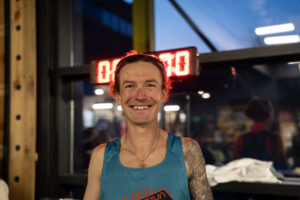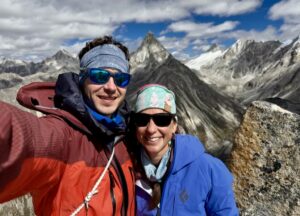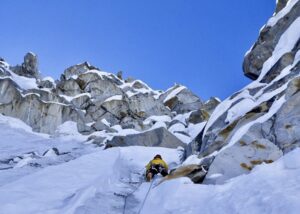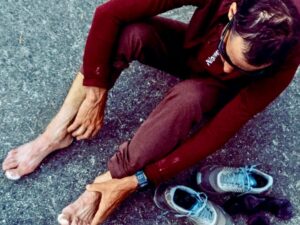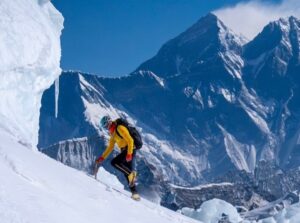High above the Bow Valley in Canada’s Rocky Mountains, trail runner Adam Mertens, 32, can spot his own home below. The comfort of a sofa and a warm meal lies in sight, but between him and that comfort are fading light and steep drops falling on either side of his feet as they skip over a chossy limestone ridge. He’s close in distance, yet worlds away up there in the alpine.
When Mertens first moved to Canmore eight years ago, trail running did not have a long history in that part of the Rockies. “A couple of key people have really cultivated it over the last 15 to 20 years. Before that, there wasn’t a ton out there.”
Unlike the trail-running mecca of Chamonix in the French Alps, there’s no gondola to the mountains of the Bow Valley. “You’ve got to work for it,” Mertens says. “Even the sport climbing here is an 800m approach to get to the crags.”
The protected national and provincial parks around the mountain towns of Canmore and Banff make trail races a little more complicated to organize. Yet the mountain running scene is slowly growing.
A new generation of Canadian trail runners is eating up big mountain linkups in the Bow Valley, where a huge swathe of jagged limestone peaks rises above the treeline to over 3,000m.

Adam Mertens trains above the Bow Valley Photo: Nikos Schwelm
Fast and technical
Mertens is one of those leading the charge, laying down fast times on highly technical routes, bringing together his overall outdoor experience in climbing, scrambling, skiing, and running.
One of the first big linkups Mertens brought this all together on is a traverse of the 11 peaks of Mount Rundle — the Rundle Traverse — a chain of peaks that looms large over the honeypot town of Banff. He first attempted the route in 2017 and has since completed it 10 times, most recently setting the fastest known time (FKT).
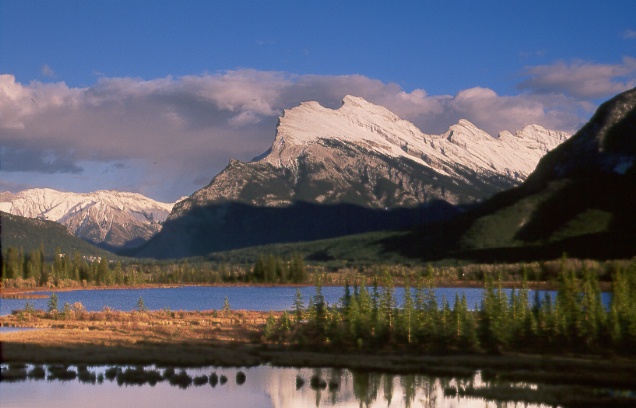
The iconic view of Mount Rundle, just outside Banff — the western end of the Rundle traverse. Photo: Jerry Kobalenko
The Rundle Traverse
Linking up the peaks of Rundle is usually a two-day mountaineering affair. When Mertens first attempted the route, he found little in the way of route beta, especially for anyone skilled or daring enough to run parts of it.
The nearly 25km traverse takes in around 2,500m of elevation gain and includes class 4-5 scrambling with some rappel sections, and requires climbing skills beyond typical trail running.
“None of it is super-difficult technically,” Mertens told ExplorersWeb. “It falls in that grey area between trail running, scrambling, and climbing.”
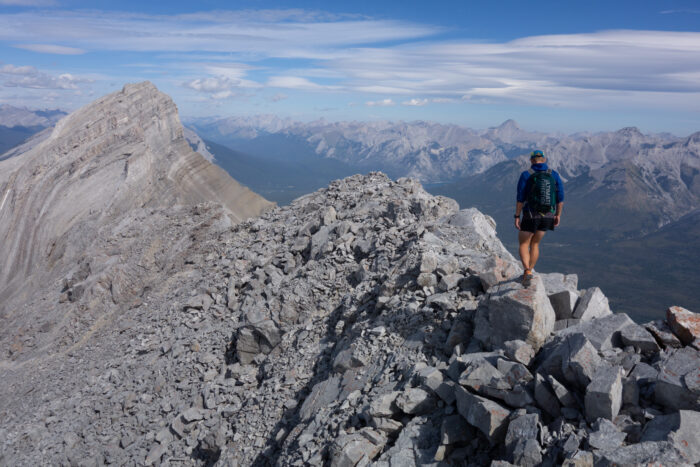
On one of the easier sections of the traverse. Photo: Nikos Schwelm
“You go out onto some potentially 5.9 terrain with exposure below you,” he adds. When you tie this in with the fact that the limestone in the Rockies is notoriously loose and chossy — some locals call the range the Rottenies — it’s clear that trail runners can’t afford to switch off.
“The reality is it’s still an alpine climb,” says Mertens. “The challenge emerges when somebody who has a trail running background, but not a climbing background, gets on that terrain.”
Mertens reckons that balancing fatigue management is also critical to keeping safe on the route. “It’s no-fall scrambling…matching the pace and the effort to the terrain, so that you come home at the end of the day.”

The mountains of the Rundle traverse, seen from Canmore. Photo: Jerry Kobalenko
New FKT
Earlier this month, on July 5, Mertens pulled together all his experience on the route to complete it in a mere 4 hours and 49 minutes, a new FKT. He took no rope, minimal water and food, using snow patches for water instead. He timed it so that he did the whole traverse in daylight — not hard in early summer at 51˚N.
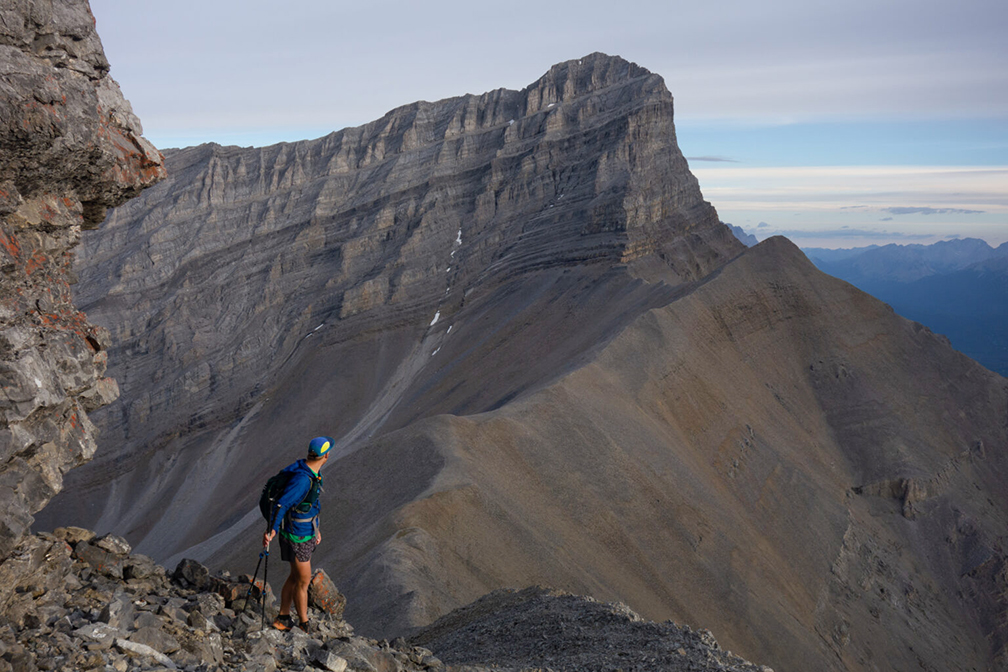
Looking back on some of the terrain covered. Photo: Nikos Schwelm
His familiarity with the route allowed him to choose efficient paths and bypass more technical sections: “As that route has evolved, and as the time on it has gone faster and faster, people have figured out different ways to do it, to avoid the rappels and to avoid particularly the crux.”
Most people who require assistance on the route get pulled off in the crux between the final two peaks on the western edge of the ridge. “It has to be the most technically challenging section of the route. But it’s also the point in the day where you’ve been moving for 10, 15, 20 hours. It suddenly feels a lot more serious.”
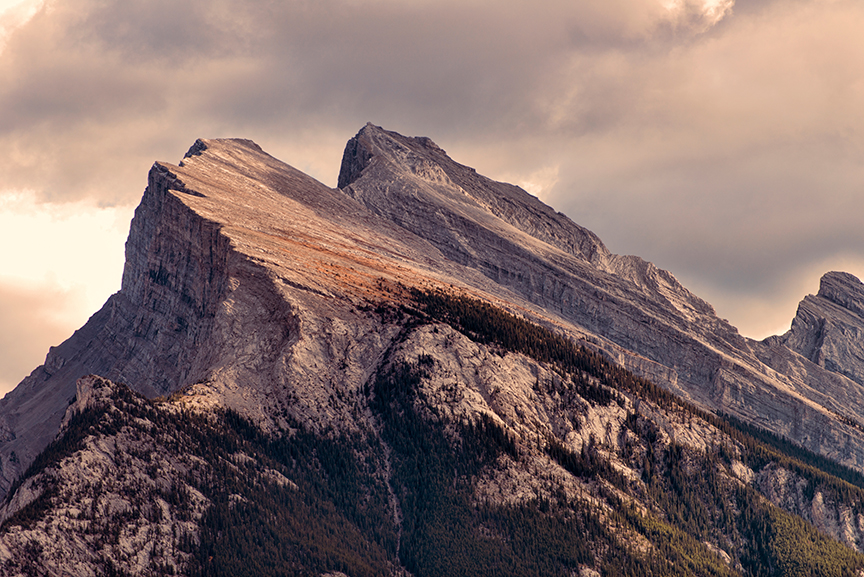
The crux of the Rundle traverse is passing from the central peak (a popular scrambling peak) to the far left peak. Crossing the scallop between them looks simpler than it is, and many scramblers unfamiliar with the challenge have found themselves in trouble here. Photo: Shutterstock
Since Mertens first started hitting the traverse in 2017, the route has become much more established with more paths being beaten in, and at least one party on the ridge most weekends during the summer months.
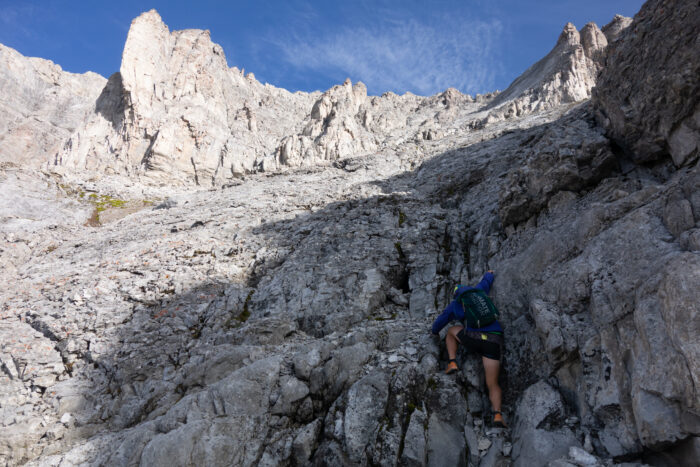
Hands on rock required. Photo: Nikos Schwelm
The ‘Bow Tie’
Mertens, who works as a hiking guide and outdoor educator, had ambitions beyond the Rundle Traverse. During the COVID lockdowns, he turned his attention to the mountains on his doorstep. It was a period when, in 2020 alone, 23 new FKTs were recorded on various routes in the Bow Valley. With a number of iconic loops already dreamt up in recent decades, Mertens set out to combine several of them into a single massive linkup he dubbed the “Bow Tie.”
“The Bow Tie combined three of the most classic big runs, including the Rundle Traverse, Canmore Quad traverse, and then the Banff Triple Crown,” Mertens says.
In the early hours of June 30, 2023, Mertens set off into the dark on what would become one of the most ambitious mountain linkups in the Bow Valley.
He began with the Canmore Quad (the four peaks of Grotto, Lady Macdonald, Ha Ling, and the East End of Rundle), continued straight into the full Rundle Traverse, and wrapped up with the Banff Triple Crown (3 peaks of West End of Rundle, Sulphur, and Cascade).
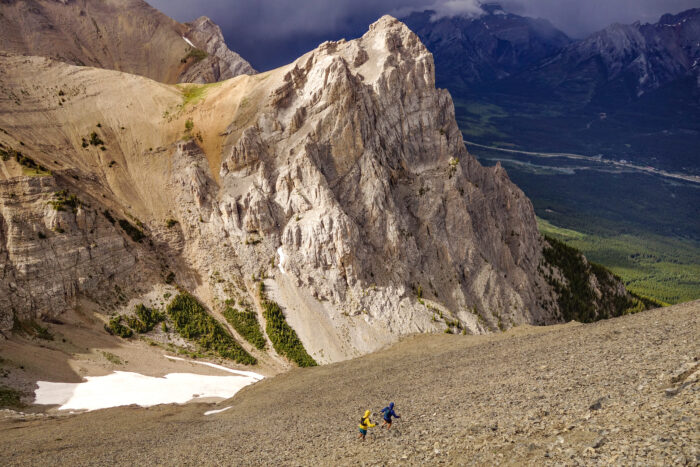
Descending the East End of Rundle. Photo: Nikos Schwelm
The 115km circuit took Mertens 32 hours to complete and included 9,500m of elevation gain. He crossed the finish line on the Bow Tie around noon on July 1.
This was Mertens’ first time running for such a long period. “It was my first time doing over 100km, so that whole experience of engaging with fatigue and knowing where it’s appropriate to take a 10-minute nap was definitely a big learning curve for me.”

Powering up the final arete on Mount Lady Macdonald. Photo: Nikos Schwelm
The Bow Valley Cirque
One of Mertens’ most ambitious efforts to date is the Bow Valley Cirque, a self-powered, high-alpine continuous 127km loop around the Canmore–Banff corridor, staying true to the ridgelines and summiting peaks via technical routes. No one had attempted this before.
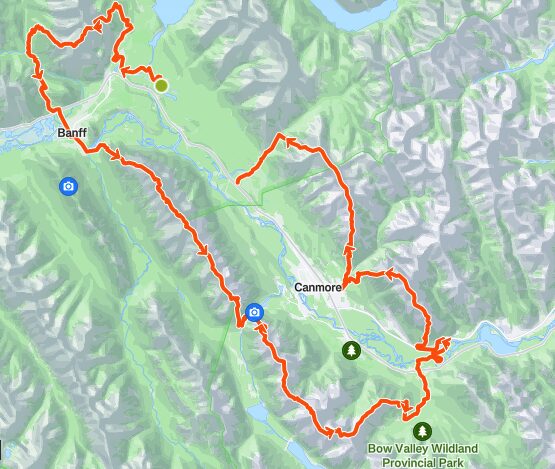
The Bow Valley Cirque attempt. Mertens didn’t quite close the loop. Photo: Adam Mertens
The Canadian trail runner wasn’t put off by the 11,100m of elevation gain, and took on the route in August 2024, going as far as he could in just over 64 hours. On the way, he slept a measly six hours.
Throughout the attempt, Mertens was supported by a team of about 10 people who helped manage key aspects like nutrition, rest, and technical challenges, while also reducing the amount of gear he needed to carry. Others pitched in behind the scenes by scouting sections of the route in advance to see if they worked or not.
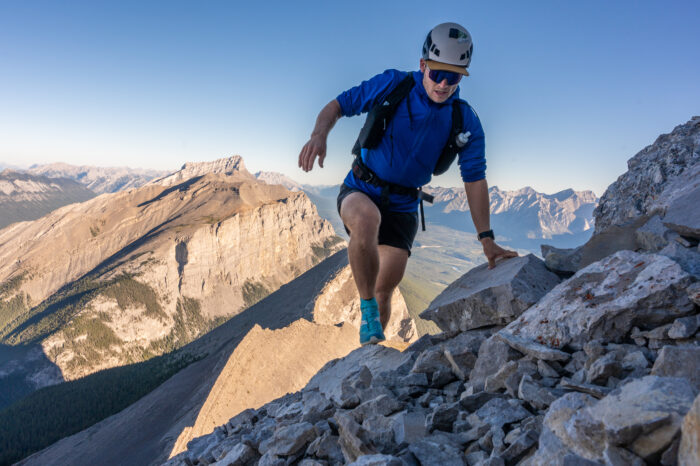
Mertens pushes hard on Mount Lawrence Grassi. Photo: Nikos Schwelm
“A lot of work went into planning the different sections. And even for all the information that we had, there was a huge piece where there were really no trip reports from people who had done it, ” Mertens notes.
The multi-skilled athlete broke the route into six different and committing chunks to allow time to catch some rest out of the alpine. “After each one of those, you’re dropping back into town. And the temptation to think ‘like, that was kind of good enough’ definitely creeps in more and more.”
“You’re in view of your house the whole time, which adds this other challenge, where you’re deep, deep in this and you’re in pretty technical terrain,” Mertens said.
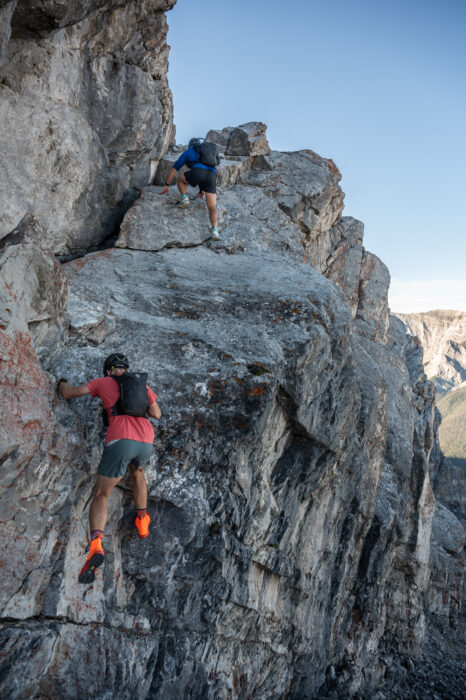
Climbing through technical terrain on the Cirque. Photo: Nikos Schwelm
Unfinished business
The last uncompleted corner of the Cirque still gnaws at Mertens, so he’s intending to go back and complete it. “We’re gonna go back this year and try to finish it. There was a piece that was unfinished.”
For now, though, Mertens seems content with soaking up everything the mountains of the Bow Valley and wider Rockies have to offer.
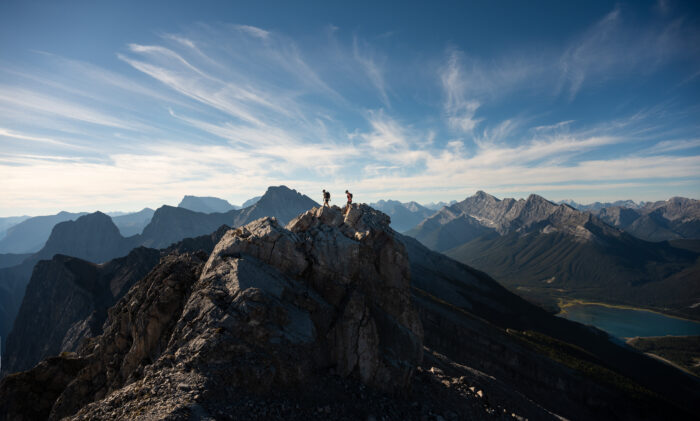
Photo: Nikos Schwelm
“There’s still so much to do just within the Bow Valley…and the Rockies,” he says. “I think it’s one of the most beautiful places in the world.”

